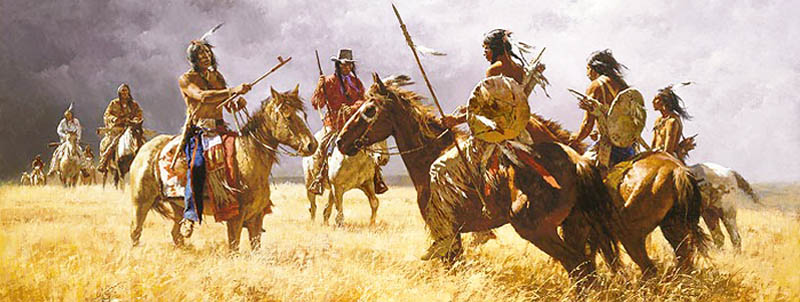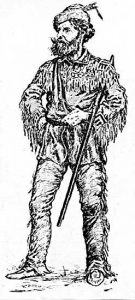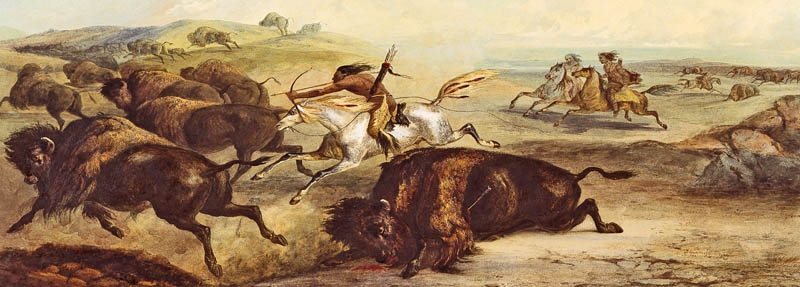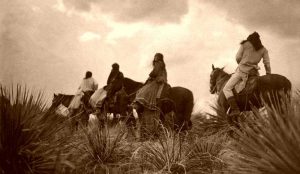
Plains Indians
Accounts of early exploration in the West show that the Padouca Indians, under their various similar names, occupied the central plains from the Black Hills region of South Dakota south to the Arkansas River and beyond nearly to the Spaniards of New Mexico.
The first definite and reliable information regarding the Padouca tribe was gained from the report of M. Du Tissenet, a Canadian explorer who visited their village in Kansas, which was 15 days march west of the Pawnee tribe, in September 1719. This was in the extreme western limit of his exploration. He spoke of the Padouca as “a brave and warlike tribe.”

Etienne Veniard de Bourgmont
In 1724, French explorer Etienne Veniard de Bourgmont made an extensive journey across Kansas Territory, from the village of the Kanza Indians on the Missouri River, near the present city of Atchison, to the village of the Padoucas at the source of Smoky Hill River. He said the Padouca had fixed villages with large houses and that they planted crops.
Before 1740, French explorers from the east sometimes used the name Padouca for the Comanche and for the Plains Apache.
Du Pratz, in his “History of Louisiana,” published in 1757, gave the following account of the customs of this ancient tribe, which he stated was taken from the journal of M. De Bourgmont:
“The nation of the Padouca is very numerous; it extends almost two hundred leagues, and they have villages quite close to the Spaniards of New Mexico. They are acquainted with silver, making the French understand they worked at the mines. The village’s inhabitants, at a distance from the Spaniards, have knives made of fire-stone, of which they also make hatchets, the largest to fell middling and little trees with; the less flay and cut up the beasts they kill.
They are almost without any European goods among them and have but a faint knowledge of them. They knew nothing of the firearms before the arrival of Bourgmont and were much frightened at them; on hearing the report, they quaked and bowed their heads.
They generally go to war on horseback and cover their horses with dressed leather, hanging down quite around, which secures them from darts. When they want horses, they train great dogs to carry their baggage.
The Padouca, who live far from the Spaniards, cultivate no grain and live only on hunting. But they are not to be considered a wandering nation, though employed in hunting winter and summer, seeing they have large villages, consisting of many cabins which contain very numerous families. These are their permanent abodes, from which a hundred hunters set out at a time with their horses, their bows, and a good stock of arrows. They go thus two or three days’ journey from home, where they find herds of buffalo, the least of which consists of a hundred head. They load their horses with their baggage, tents, and children, conducted by a man on horseback. When they come to the hunting spot, they encamp near a brook where there is always wood; the horses they tie by one of their fore-feet with a string to a stake or bush.
The following day they each mount a horse and proceed to the first herd with the wind to their back. The buffalo may scent them and take flight, which they never fail to do because they have a very quick scent. Then the hunters pursue them close, at an easy gallop, and in a crescent, or half ring, till they hang out the tongue through fatigue and can do no more than walk. The hunters then dismount, point a dart at the shoulder extremity and kill each of them one cow, sometimes more; for they never kill the males. They then flay them, take out the entrails and cut the carcass in two; the head, feet, and entrails they leave to the wolves and other predatory animals. The skin they lay on the horse, and on that the flesh, which they carry home. Two days after, they go out again, and then they bring home the meat stripped from the bones; the women and young people dress it in the Indian fashion, while the men return for some days longer to hunt in the same manner. They carry home their dry provisions and let their horses rest for three or four days, at the end of which those who remained in the village set out with the others to hunt in the same manner, which has made ignorant travelers affirm this people was a wandering nation.”

Lewis and Clark with Sacagawea, guiding them.
Lewis and Clark, when they came through in 1804, recorded that the Padouca lived in fixed villages.
Lieutenant Zebulon M. Pike explored Kansas and Colorado in 1806 and stated that Padouca was the Pawnee name for the Comanche. However, the Pawnee Indians declared that the Comanche did not raise crops and had no fixed villages.
Jacob Fowler, of the Glenn–Fowler expedition to Santa Fe, New Mexico, in 1821, found, with the Kiowa, some people whom he called Kiowa-Padduce and Padduca-people who were not Comanche.
On maps of the time, the Kansas River was sometimes called the Padouca River, and Padouca villages were located at the sources of both the Kansas River and the Arkansas River.
The name was familiar for 100 years before it passed out of use. It appears in early maps but not in a way to indicate much about the tribe’s relationship with other people.
The Padouca were of an “unknown race and language,” with habits in many respects dissimilar from any other nation. Instead of being indiscriminately thrown together in a confused mass of lodges, their villages were laid out regularly with streets, which formed squares, as in a modern city. The houses were neatly built, and the Indians, in intelligence and living habits, ranked higher than the more eastern tribes, who were almost continually at war. Little is known of their history after the visits of the French during the first quarter of the 18th century.
Whether the tribes toward the east united with the Pawnee for their destruction or whether disease did its fatal work among them is only a matter of conjecture. As a nation, they long ago disappeared, and the roving bands of Kiowa and Kaskaia, whose language bears no similarity to the Dakota and who, from their haunts in the Black Hills, long came down to hunt in the region where the Padouca formerly lived, are supposed to be the last remnants of the great nation of the Padouca.
In the end, George Bird Grinnell, an American anthropologist, historian, naturalist, and writer, gave his opinion in 1920 by stating:
“The evidence is not conclusive as to who the Padouca were, but it convinces me that the Padouca were not Comanche, and I am disposed to regard them as Apache.”
© Kathy Alexander/Legends of America, July 2023.
Also See:
Native American Archaeological Periods
Native American Photo Galleries
Native Americans – First Owners of America
Sources:
Cutler, William G; History of Kansas; A. T. Andreas, Chicago, IL, 1883.
Explore Kentucky History
Grinnell, George Bird; Who Were the Padouca? American Anthropologist, New Series, Vol. 22, No. 3 (Jul. – Sep. 1920)
Kansas State Historical Society


